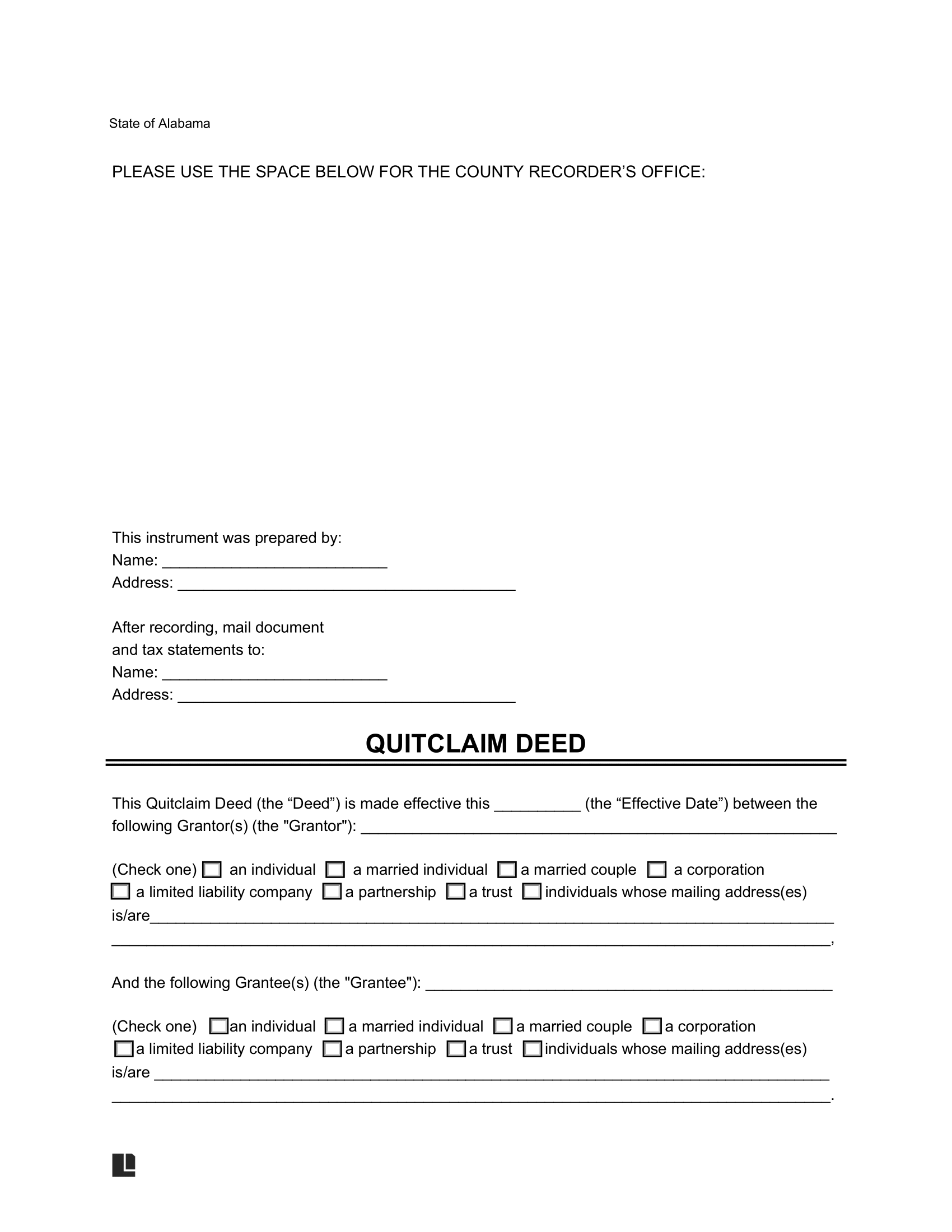Quitclaim deeds offer a simplified approach to transferring real estate ownership in Alabama. Compared to standard warranty deeds, which involve title searches and guarantees of clear title, quitclaim deeds focus solely on conveying the grantor’s existing interest in the property. Thus, they are a faster and more cost-effective option.
However, the responsibility of researching potential title issues falls entirely on the recipient. This makes quitclaim deeds suited for trusted situations where title clarity is less of a concern, such as gifts between family members or correcting minor title errors.
Legal Framework
Ala. Code § 35-4-1 grants property owners over 19 years of age the right to convey property to other individuals immediately or in the future by writing or through a will, as long as the conveyance is consistent with state laws.
Additionally, a valid Alabama quitclaim deed must meet the following requirements:
Legal Description
Any deed conveying property must include a legal description of it consistent with Ala. Code § 40-7-16. Most grantors use the existing property title. This may include the following:
- Numbered section, township, and range.
- Subdivision designation.
- Metes, bounds, and acreage.
- Plat, lot, or block number.
The primary goal of the legal description is to clearly locate and identify the property and establish its size and quantity.
Signing
- Ala. Code § 35-4-20 requires quitclaim deeds and other documents that convey property to be written or printed wholly or partially on paper or parchment. A quitclaim deed must be signed by the grantor, who is the person conveying the property, and at least one witness.
- The state signing requirements provide for individuals incapable of signing their own names. If the contracting party has a representative sign for them, the agreement must be witnessed and signed by two individuals capable of signing their own names.
Terminology
State law prohibits language that implies warranty of ownership or title, such as “grant,” “bargain,” or “sell” (Ala. Code § 35-4-271).
Marital Status
Per Ala. Code § 35-4-73, the grantor or vendor conveying the property must indicate the grantor’s marital status. This is because Ala. Code § 6-10-3 prevents a person from conveying property without the voluntary assent of the grantor’s husband or wife if the property is an owner-occupied homestead dwelling.
Additional Documents
The deed must be accompanied by a Real Estate Sales Validation Form, which verifies the transferred property’s actual purchase price or value (Ala. Code § 40-22-1).
Filing
- Property conveyance must be recorded with the office of the probate judge in the county where the property exists (Ala. Code § 35-4-50).
- Recording the deed in the appropriate county probate office serves as effective notice of the conveyance (Ala. Code § 35-4-63).
Validity Requirements
To ensure validity, Alabama quitclaim deeds should include the following details:
- Filing location: The deed must be filed in the county where the property is located.
- Written or printed: The document must be written or printed on paper or parchment.
- Required signatures: The deed must be signed by the grantor and one witness if the grantor can sign for themselves. If the grantor cannot sign for themselves, the deed must be signed on their behalf by an authorized representative and two witnesses.
- Spouse approval: If the property is co-owned by a married couple, both spouses must sign. If only one spouse owns the property, they can be the only signing grantor, but only if the property is not a designated homestead.
Content Requirements
A quitclaim deed in Alabama must follow certain content guidelines to be valid:
- Legal description: The deed must include a legal description of the property, which can usually be found on the property title.
- Grantor details: The grantor’s full name, address, and marital status must be included.
- Grantee information: Add the grantee’s name, address, and property transfer details.
- Homestead requirements: If the property is a designated homestead, the quitclaim deed must be signed by both spouses.
- Non-homestead statement: If the property is not a designated homestead, the grantor must include a formal statement to that effect.
- Language: Avoid terms that imply warranty and ownership. Use terms like remise, release, and quit claim or quit claim and convey instead.
Quitclaim Deeds vs. Other Property Transfer Methods
| Quitclaim Deed | Conveys property without guarantees about the title. If the grantor does not own the property, the grantee does not have any rights to the property The grantee has no grounds to sue for title issues, because the deed provides no warranty. |
| General Warranty Deed | Provides a full warranty of title and guarantees that the property tile is free and clear of any encumbrances. This type of deed carries the highest level of liability for the person conveying the property. |
| Special Warranty Deed | Offers a partial warranty of title. The grantor is responsible only for property issues that arose during the grantor’s ownership term. It absolves the grantor of any responsibility for title issues that may have occurred before they took ownership. |
| Title Insurance | Allows grantees who receive property from an Alabama quitclaim to reduce their financial liability. For a premium, title insurance protects the buyer from title fraud, forgery, liens, document errors, and other title problems that may arise. |
| Life Estate Deed | Helps the property owner avoid probate and joint tenancy costs. The grantor retains the right to live as a life tenant in their home while they are alive. Upon the life tenant’s death, the grantee, called the remainderman, becomes the sole property owner. |
| Survivorship Deed | Property owners can also avoid probate by having multiple owners on the title. Similar to a life estate deed, this document automatically transfers ownership of the property to the co-owner upon the other owner’s death. |
